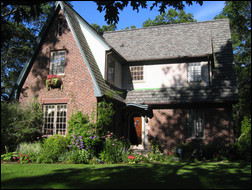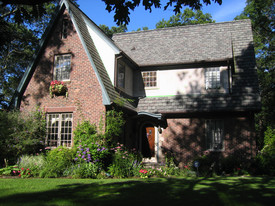For owners of vintage homes, renovations come at a price–and a responsibility. These homeowners often see their roles as stewards of history, ensuring future
 The architectural integrity of this English Tudor has been maintained through every renovation. Credit: Laurie Bloom |
generations will be handed down the same beauties they’ve been entrusted with. And that means taking steps to safeguard their home’s irreplaceable characteristics. In retrofitting their residences with 21st creature comforts, their priority is to carry out alterations without compromising the authenticity of the architecture.
“Certain people have a strong sense that the best of American architecture has gone, and they’re trying to preserve what was very distinctive and beautiful,” says Lawrence Motta, senior estimator for Matarozzi/Pelsinger Builders, a San Francisco-based residential building company that’s restored dozens of Victorian, Edwardian and turn-of-the-20th century buildings.
Remaining Faithful
Laurie Bloom, of Brightwaters, N.Y., lovingly calls her 1910 Tudor style home a “money pit." In the decade she and partner Len Thon have owned the home, the couple has made a deliberate effort to stay “true to the architectural character of the house,” she says. They’ve done that by ensuring every element is faithful to the period. Some of the projects they’ve carried out include replacing windows with custom mullioned casements; swapping modern lighting for period chandeliers, sconces and pendants; and returning the kitchen to its century-old roots. Their commitment to the architecture extends throughout the property with three rock walls, vast flowerbeds and numerous evergreens in keeping with the English Tudor design.
”Extensive planning went into the design and materials selection to ensure that it looked appropriate to the house,” says Bloom. For the patio, it took visits to four stone yards just to find the right bricks that didn’t look “shiny and new.”
That’s not to say they sacrificed comforts. They installed central air conditioning and in-ground sprinklers. Still, Bloom says, “We’ve taken a great deal of time to work through the decisions associated with each project, carefully emphasizing that the goal is to make it look like it has always been here. That’s been my mantra, and I think it has served us well.”
Determining Value
While the Bloom-Thon Tudor has historical significance, not all aging homes do. Old doesn’t always mean valuable. According to Dean Bennett, president of Dean Bennett Design and Construction in Colorado, “Just because it was a style of its day doesn’t necessarily mean it’s a style looked upon favorably, a style that is well-built or worth saving.” Some homeowners get so emotionally invested they wind up spending more to preserve details of questionable quality than they would have had they demolished and started from scratch.
In some cases, the decision is not the homeowner’s alone. In different municipalities, historical review boards dictate the style, paint colors and changes that can be made to the façade, so it’s important to make town hall your first stop.
The next step is to research the architectural style of your home and catalog the interior and exterior details.
Lawrence Motta says many older homes have been remodeled over the years so it can take some sleuthing on the part of homeowners to find out the original architectural details. A lot of information about your particular home’s past may
 Carpets were pulled up in this mid-century home to find wood floors in pristine condition. Credit: Mike Hogan |
be on record in town hall. In addition, there’s a wealth of information online for every building style as well as for many name builders. Web sites, blogs and forums can be found for owners of, say, Greene and Greene Arts and Crafts bungalows and Joseph Eichler modernist homes. “The most important resource is the Internet,” Motta says. “People are talking to each other and sharing resources. You need to get in touch with them if you’re going to preserve an architecturally distinctive home.”
Restore, Not Replace
When Mike Hogan bought his 1956 Cape Cod style home in Columbus, Ohio, four years ago, he instantly knew which elements were irreplaceable. No matter what home projects he would eventually undertake, the existing hardwood floors, woodworking, doors, hardware, tub and plaster walls were going to stay.
Hogan took a restore-not-replace mindset. He tore out old carpet and exposed the original hardwood floors. They were in pristine condition. Instead of replacing interior doors, he painted them with an oil-based white paint to give the home a fresh look and polished up the original hardware. “It’s amazing what a little paint and polish can do,” he says.
When it came to his kitchen, Hogan decided that replacing his cabinetry would take away from the original look and feel he wanted to achieve. What’s more, he says, the craftsmanship would be hard to equal. Instead, he painted the cabinets and replaced the appliances.
“Sometimes it can be a big decision whether you decide to start from scratch or use what you have,” Hogan says. “You might kick yourself in the butt if you find out that porcelain tub is worth thousands of dollars and now it’s sitting in a dump yard or being sold on eBay.”
Keeping key elements that reflect your home’s unique design and then surrounding them with updated features is a good strategy for maximizing your home’s character.
Realize, too, that you’re not limited to the design elements that are already there. Scan books and online resources to see what period-appropriate details haven’t yet been used and consider incorporating them. “In the design process, we look to repeat the chosen details to a level as far as we can go throughout house, all the way down to drawer pulls,” Bennett says.
Preserving the aesthetics of an older home takes time—something both builders and homeowners agree should be factored into any renovation schedule. Custom milled moldings, for instance, take a lot longer to make than buying off-the-shelf stock. Motta suggests snapping digital pictures of any architectural details you plan to replace and bringing the images to the local mill shop or fabricator to make sure they can be reproduced before you commit to ripping out the original.
Mike Hogan admits that working with the original characteristics of an older home takes a lot of time and sweat equity but says the payoff is worth it. “In the end, you’ve maintained the character of the home which, to me, makes a home a home.”
Credit: Renovate Your World




























